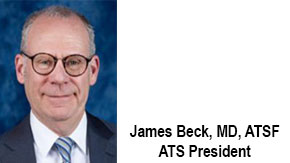Last month’s President’s Message focused on how members at all stages of their careers can become more involved with ATS, but this month I would like to focus on activities for early career professionals. Attracting and  retaining junior members is extremely important for all societies, and, for the ATS, this means encouraging the next generation of clinicians, researchers, educators, and leaders.
retaining junior members is extremely important for all societies, and, for the ATS, this means encouraging the next generation of clinicians, researchers, educators, and leaders.
The ATS Executive Committee and Board of Directors pay close attention to demographic trends in our membership, as well as trends in meeting attendance. I am very pleased to report that early career professionals comprise an increasing proportion of both our membership and conference attendance, and this includes U.S. and international members. To me, this indicates that ATS is providing value to our new members, but we must do more to assure that those members remain engaged with the society.
ATS has several committees that focus on early career professionals. Our Education Committee plans, executes, and evaluates all educational activities except for the International Conference, and one of their tasks is to define educational methodology that matches the expectations of junior members. The Members in Transition and Training (MITT) Committee is primarily comprised of early career professionals and focuses exclusively on their needs within ATS. Our Training Committee takes the lead on all aspects of clinical and research training for adult and pediatric pulmonary, critical care, and sleep medicine. The Membership Committee’s benchmarks include increasing the value of membership for new members and identifying ways to retain those members. As in my message last month, committee assignments for these (and other committees) will begin just after the New Year. Members who are interested in volunteering for committee assignments should signal their interest as soon as possible in the ATS portal.
In addition to committee activities, early career professionals are essential for the success of our assemblies. All assemblies focus on early career professional engagement, many offer fantastic mentoring programs, and many have established workgroups for early career professionals. My consistent advice for early career professionals is to identify a relevant assembly and become involved; it’s a great way to network and to learn more about ATS. In fact, this is how I got started in ATS activities as a fellow.
Finally, our International Conference offers a wide variety of activities that have been extremely popular. These include our Resident Boot Camp, our Fellows Track Symposium, our Student Scholars program, and our recently established New Faculty Boot Camp. The 2020 application portals for each of these programs are live; to learn more about please visit https://conference.thoracic.org/program/early-career-professionals/index.php. During the conference, there are many career development sessions of interest to early career professionals. I encourage you to stop by the Center for Career Development to learn more.
As you think about the activities you’d like to pursue, I highly recommend searching the ATS web site for the information you need. A great place to start is our Career Development page, which will link you to the appropriate information for medical students and residents, fellows, and junior faculty.
For all of our early career professional members, ATS welcomes you and strives to provide value for your membership. We are interested in your thoughts and ideas, and many of the opportunities I’ve described originated with suggestions from our junior members.
On behalf of the ATS Executive Committee, the Board of Directors, and the ATS staff, I wish all a happy holiday season, and a joyful and productive New Year.

